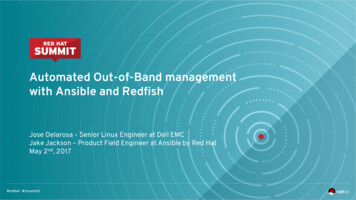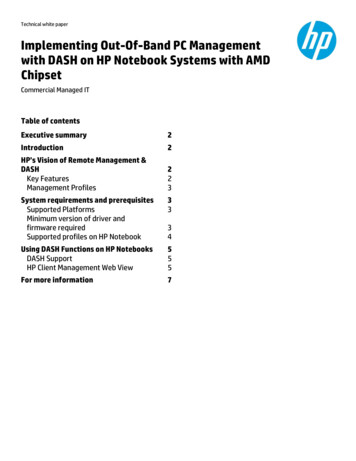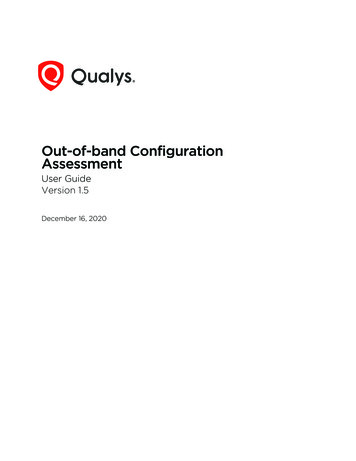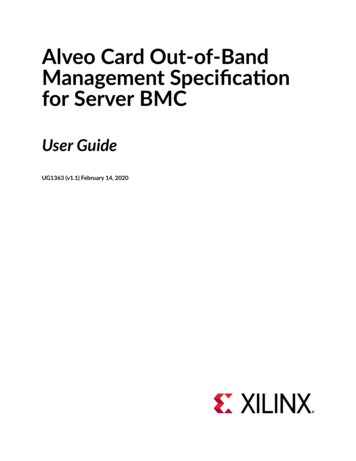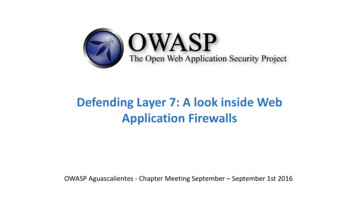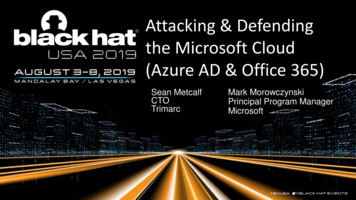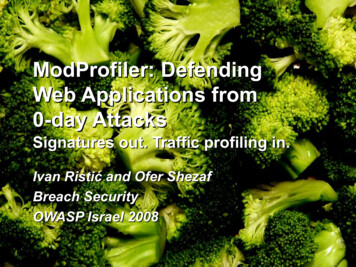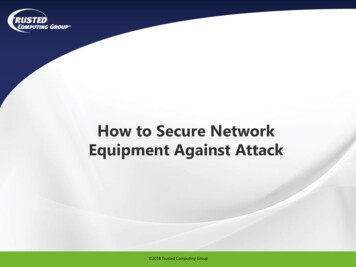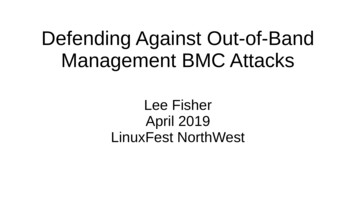
Transcription
Defending Against Out-of-BandManagement BMC AttacksLee FisherApril 2019LinuxFest NorthWest
"Imagine trying to secure a computer with a small butpowerful parasitic server on its motherboard; a bloodsuckingleech that can't be turned off and has no documentation; youcan't login, patch, or fix problems on it; server-baseddefensive, audit, or anti-malware software can’t be used forprotection; its design is secret, implementation old, and itcan fully control the computer's hardware and software; andit shares passwords with a bunch of other important servers,stores them in clear text for attackers to access. Not tomention it was designed for full control, remote managementand monitoring, and it’s pretty damn good at it."--Dan Farmer, 2013
Agenda BMC/LOM concepts MC/SP (Intel ME/AMT, AMD PSP, Apple T2, .) IPMI Intel SMM WS-MAN SMASH and DASH OpenBMC Redfish “IPMI ” (HP iLO, Dell iDRAC, .)
Credits All security guidance in this talk comes fromexisting BMC security research from:Dan Farmer, HD Moore, Matias Soler, NicolasWaisman, Fabien Périgaud, Alexandre Gazet,Joffrey Czarny, Adrien Guinet, Jesse Michael,Mickey Shkatov, Oleksandr Bazhaniuk,.and others that I am forgetting (sorry)
CPU (and SMM) In early systems, the CPU was in charge of everything. Via the CPU, thefirmware and OS code talked to the registers, RAM, and I/O busses. The CPUwas in charge of system security.– This is the traditional model that attackers use, OS/app-level malware.On modern Intel (and AMD) systems, in addition to normal CPU mode, the CPUhas a new mode, SMM (Systems Management Mode). SMM code can see allthe normal CPU can see, plus SMBIOS and SMRAM, which normal CPU modescannot see. See later slide on SMM and IPMI.–Attackers are also using SMM.–The rough equivalent of Intel SMM on ARM is TrustZone,both are called “Management Mode” from UEFI firmware perspective
Baseboard Management Controller(BMC) On modern x64 server systems, the CPU is no longer in charge ofsystem security, a new BMC chip isBMC is a separate chip beyond the CPU, which can see all the CPU’sresources (but the CPU cannot see the BMC)BMCs are mostly in server-based systems, but also in some [“businessclass”] desktop/mobile systems (eg, see DASH and Intel AMT/ME)An embedded device with an independent microprocessor used toperform systems monitoring and management-related tasks on acomputer system, in-band or out-of-band
Lights-Out Management (LOM) Convenience features added to help sysadmins remotelyadminister systems, mostly servers but also enterprisedesktop/laptops. LOM are the core features of a BMC. Attack surface which can be used by to remotely attack systems Standardized in (IPMI, SMASH, DASH, Redfish, ) Vendors include vendor-centric services/protocols and tools Can be used in-bound or out-of-bound
Out-of-Bounds Management Normal computing is done with using main CPU, as result of end-userbooting an OS and running an app (“OS-present app”). We think theOS is talking to the CPU to run the app– Or perhaps instead of an OS-present app, using a “pre-OS app”, like a UEFIShell command line tool. Firmware is talking to the CPU to run the appOut-of-Bounds Management is when using BMC to control systemoutside the scope of the main CPU. OOB mgmt works when computeris ‘powered off’ (CPU is not running)Most operate remotely via Ethernet, but some use WiFi
Intel ME/AMT The Intel ME chip and it’s AMT software is used by Intel formultiple things, including being a LOM chip Like SMM and BMC, Intel ME is mostly invisible to CPU Unlike most BMC usage, Intel ME is on most desktops AMD systems have the AMD PSP (Platform Security Processor)chipI believe new Apple systems have the Intel ME chip as well asthe new Apple T2 processor
Management Controllers (SecurityProcessors) In addition to CPU, and BMC, modern systems (all x64 systems, not justservers) also now have a Management Controller or Security Processor, whichis not strictly BMC/LOM-focused but some have some BMC features (securethe boot process from attacks, invisible management tasks in background)– This is a separate chip from CPU and BMC, with an embedded OS andanother attack surface in addition to BMC and CPU surfaces. Similar systemcontrol issues as with BMC vulns.– Examples: Intel ME/AMT, AMD PSP, Apple T2Example: Intel ME/AMT password vuln (INTEL-SA-00075, CVE-2017-5689 (?))Unsure which of these stay running when CPU is powered off
BMC Standards Intel IPMI DMTF SMASH DMTF DASH DMTF Redfish .
BMC Interfaces PECI (Platform Environment Control Interface) HECI (Embedded Controller Interface) PLDM (Platfform Level Data Model) PMCI (Platform Management Components Intercommunication) MCTP (Management Component Transport Protocol) NC-SI (Network Controller Sideband Interface) HP RIBCL (Remote Insight Board Command Language) SMbus .
BMC and NIC(s) How can IPMI (or Redfish or SMASH, etc.) do networking?1) Dedicated BMC NIC2) Piggyback on Host NIC Another related BMC net security issue:–Most use Ethernet-based NICs–But now a few vendors are starting to use WiFi-based NICs! Cannot isolate BMC network traffic!Cannot isolate BMC network traffic!Some BMC protocols still expose username/password data in plaintext!Understand how a vendor implemented above before buying server
BMCs and Mobile Apps At least one OEM makes a smartphone app that lets sysadmins remotely controlsystems using IPMI.Today, you have to secure access to BMC network traffic, probably via a sysadmin’sdesktop/laptop.Using a smartphone gives an attacker more ways to get control of your network.More attack surface to defend.How do you keep your BMC network traffic local if you send it through a phonecarrier’s network?IPMI protocols aside, similar issues with WWW protocols and Redfish, and WS-MANbased management, they can be used on a mobile device. Similar issue with anyBMC web interface.
Vendor-Specific Implementations Each vendor has their own closed-source codebase:–HP: iLO–Dell iDRAC–Oracle/Sun: ILOM–AMI: MegaRAC–IBM/Lenovo: IMM, IMM2–Fujitsu iRMC–SuperMicro IPMI– There is one main open source multi-vendor BMC project: OpenBMC
Vendor-Specific Technologies Vendors extend an industry standard (IPMI, DASH,SMASH, Redfish) and add their own featuresSome of the extras network server/client protocols(incomplete list):–Telnet, SNMP, FTP, SMTP, VNC, SSH, LDAP, RADIUS,HTTP, HTTPS, SSH, WS-MAN, DHCP, RDP, AD, vendor-centric network protocols , .
OpenBMC OpenBMC is an open source Linux BMC implementation used bymultiple vendors IBM uses it on OpenPOWER systems Yocto Linux-based IPMI support Redfish support in recent release Actively working on security issues! Related to the Open Compute Project
Intelligent Platform ManagementInterface (IPMI) The IPMI specification defines a set of common interfaces to a computer systemwhich system administrators use to monitor system health and manage the system.IPMI operates independently of the OS and allows administrators to manage asystem remotely even without an OS, system management software, and even if themonitored system is powered off (along as it is connected to a power source). IPMIcan also function after an OS has started, offering enhanced features when usedwith system management software Initial stakeholders: Dell, HP, Intel, and NEC V1.0 released on 1998-09-16, V1.5 on 2001-03-01, and V2.0 on 2004-02-14. Spec was “frozen” on March 2019
IPMI Features IPMI Features:–Remote power control–Serial over LAN–Watchdog–Boot order–Sensor monitoring–Alarms
IPMI and SMM Modern Intel CPUs have a System Management Mode (SMM), inaddition to their normal operating mode.IPMI talks about SMM, the usefulness of System ManagementInterrupts (SMIs) with IPMI. Attackers may be able to leverage SMMattacks with their IPMI attacks.CPU/SMM interaction is somewhat similar to CPU/BMC interaction:–SMM can see an do more with system than normal CPU mode,–like BMC can do more with system than the CPU.
Some IPMI security issues IPMI 1.x:–NULL authentication option–NULL user option–Anonymous–UDP-based RMCP (Remote Management Control Protocol) vulnerable to multiple networksecurity attacks (password sniffing, network spoofing, connection hijacking, MitM attacks, .)IPMI 2.0:–Cipher Zero (passwords ignored!)–RAKP (RMCP Authenticated Key-Exchange Protocol) passwordsRead Dan Farmer’s IPMI security research for details!!
IPMI attack surface Once attacker has access to a BMC, they can compromise it'shost server (firmware, OS)But they can also compromise other hosts–IPMI management groups share common passwords web interface: TLS certs, expired/revoked/self-signed/. Passwords stored on Flash or in RAM–IPMI passwords stored on Flash: Hardware LifecycleDecommission/Disposition phases
WS-Management Non-RESTful, WSDL/SOAP-based XML-basedinterfaces for managing systems, both for OSpresent code as well as for OOB use. DMTF SMASH and DASH are WS-MAN-based Redfish uses RESTful-based interfaces
Desktop and Mobile Architecture forSystem Hardware (DASH) DMTF's WS-Management-based system managementstandard for desktop and mobile client systems,providing out-of-band and remote management ofdesktop and mobile systems. DASH provides supportfor the redirection of KVM and text consoles, as wellas USB and media, and supports the management ofsoftware updates, BIOS, batteries, NIC, MAC and IPaddresses, as well as DNS and DHCP configuration
Systems Management Architecturefor Server Hardware (SMASH) DMTF's WS-Management-based standard for servers, providesthe ability to remotely manage a platform independent of machinestate, operating system state, server system topology or accessmethod – interoperable management is possible before the OS isoperational, when the OS is hung, or while the OS is up. SMASHspecifies two interfaces, web services and command line. Theweb services are based on DMTF Web Services for Management(WS-Man). The command line is described in ServerManagement Command Line Protocol (SM CLP)
Redfish DMTF’s Redfish is an extensible management standard using adata model representation inside of a hypermedia RESTfulinterface. Since it is model oriented, it is capable of expressing therelationships between components in modern systems as well asthe semantics of the services and components within them. Themodel is exposed in terms of an interoperable Redfish Schema,expressed in an OData Schema representation with translations toa JSON Schema and OpenAPI representations, with the payload ofthe messages being expressed in a JSON following OData JSONconventions.
Redfish Features
Redfish Redfish replaces (or at least competes with) SMASH, DASH, IPMI,and Intel AMT as the new LOM interfaceRedfish relies on HTTP/HTTPS for transport and OData-flavoredJSON for dataThere are DMTF-based schemas, and vendor-centric onesAFAICT, most vendors are implementing Redfish using theirexisting LOM technologies (HP iLO, Dell DRAC, Lenovo IMM, etc.)OpenBMC just recently started supporting Redfish
DMTF Redfish tools on Github
Redfish standards Redfish tries to leverage modern existingstandards, including:–URI, HTTP, TLS–UPNP’s SSDP–HTTP-based alert subscription–JSON and OData v4, CSDL, JSON Schema
Redfish: security There is very little existing documentation focusing on securing Redfish, itdefers to existing HTTP/JSON/OData security best practicesRedfish defers to WWW for security/authentication, see HTTPS guidance(OWASP, etc.) Look at the Redfish spec to see what HTTPheaders/requests/responses are needed and any Redfish-centricassumptions.Treat Redfish as the most critical web app which your company needs tosecure from attackers Isolate the network where Redfish traffic occurs Restrict access to network to only authenticated users.
BMC Security Tools Metasploit IPMI modules IPMIPWN Ipmitool, OpenIPMI, FreeIPMI, . IPMI password cracking: hashcat, john-the-ripper iLo Toolkit (Redfish-based, HP iLO-centric) vendor-centric-tools. traditional embedded system/IoT tools.
BMC Hardening Checklists Understand which NIC(s) and what protocols your LOM solutionsuse–IPMI: read Dan Farmer’s Security Best Practices!!!–SMASH and DASH: use WWW/WS-Man/XML/SOAP/WSDL securitybest practices–Redfish: use existing WWW/HTTP/JSON/OData security best practicesPreOS Security will have an upcoming BMC security bestpractices quick references shortly.https://preossec.com/
Calls To Action Learn how to secure the BMCs of all systems you maintainDMTF Redfish WG and/or Web security community: help sysadminsBlue Teams with Redfish defensive best practices. Redfish tools areamongst the most important enterprise web apps that need securing,DMTF writes vendor-centric docs and need sysadmin-centric docsSysadmin community: update documentation and certificationtraining materials to add BMC securityIntel: create an ME/AMT security best practices document
More Information Vendor standards:–Intel IPMI mi/ipmi-home.html–DMTF Redfish, https://redfish.dmtf.org/–DMTF DASH, https://dmtf.org/–DMTF SMASH, https://dmtf.org/–Intel Corp, “Intel Sideband Technology: An Overview of the Intel ServerManageability Interfaces” ml
More Information Sysadmin-focused documentation on using Redfish:–ADMIN Magazine: Redfish System Management –Red Hat Summit 2018: anagementUsing Ansible and Redfish to Automate Systems Managementhttps://www.youtube.com/watch?v ems-managementOpenSource.com: Out-of-band management with Redfish and Ansible ement-redfish-and-ansible
More Information Industry security guidance:–US-CERT: Risks of Using the Intelligent Platform Management Interface (TA13207A), sco: IPMI Security Vulnerabilities, /ipmi-vulnerabilities.html–IBM: IPMI best ter/en/P9ESS/p9eih/p9eih ipmi bestpractices.htm–SuperMicro, “Best Practices: BMC o/files/IPMI/Best Practices BMC Security.pdf
More Information Security research:–Dan Farmer, IPMI research, http://fish2.com/ipmi/–Dan Farmer, “IPMI Security Best Practices”, http://fish2.com/ipmi/bp.pdf–HD Moore, “A Penetration Tester's Guide to IPMI and BMCs”, estersguide-to-ipmi/–Joffrey Czarny, Alexandre Gazet, Fabien Perigaud, "Subverting your server through its BMC: the HPE iLO4 case",https://recon.cx/2018/brussels/talks/subvert server bmc.html–Matias Soler, Nico Waisman, 'The Unbearable Lightness of BMC’s", �Jesse Michael, Mickey Shkatov, Oleksandr Bazhaniuk, "Remotely Attacking System mware-11588–Joffrey Czarny, Alexandre Gazet, Fabien Perigaud, "Backdooring your server through its BMC: the HPE iLO4 dooring your server through its bmc the hpe ilo4 case/–Joffrey Czarny, Alexandre Gazet, Adrien Guinet, Fabien Perigaud, “Defeating NotPetya from your iLO4”, ating NotPetya from your iLO4-guinet-perigaud-gazet-czarny.pdf
Questions? Comments? Questions? Thanks for attending! Slides will be posted in an upcoming blog postto FirmwareSecurity.com in a day or two,thanks for your patience.
Image Credits All embedded graphics were done by others, I snipped them forthis presentation. I’m grateful for their graphic abilities.IPMI graphics:–Wikipedia, IPMI–Advances in Intelligent Platform Management: Introducing the NewIPMI v2.0 Specifications, Tom Slaight, Intel, 2004/02, Intel IDCRedfish graphics:– FIXME: info on dmtf.org-based slides on Redfish
Baseboard Management Controller (BMC) On modern x64 server systems, the CPU is no longer in charge of system security, a new BMC chip is BMC is a separate chip beyond the CPU, which can see all the CPU’s resources (but the CPU cannot see the BMC) BMCs are mostly in server-based systems, but also in some [“business class

